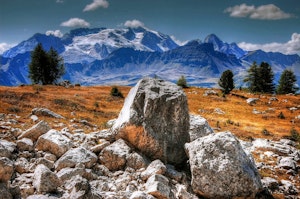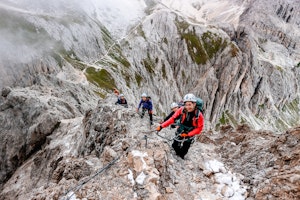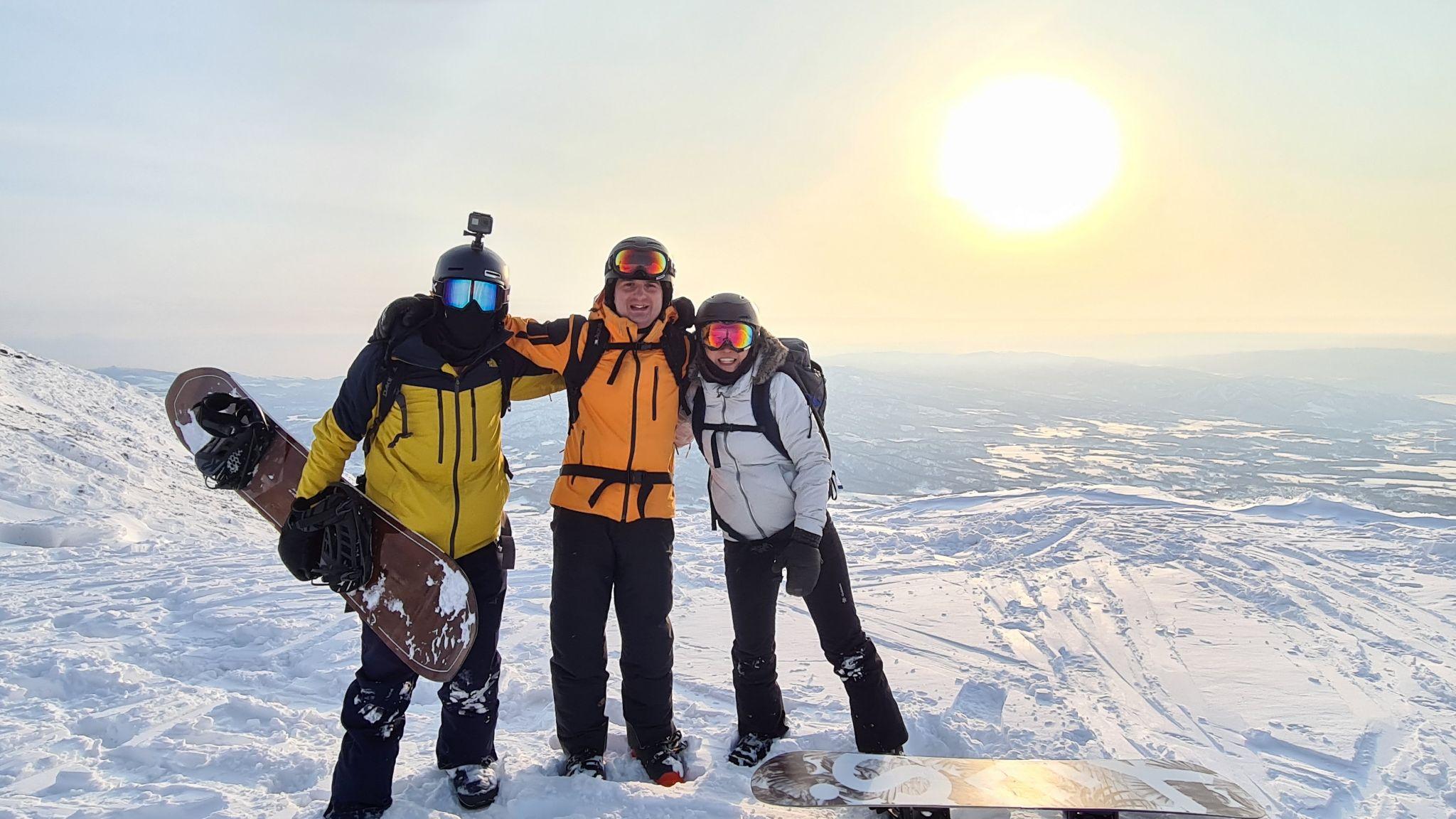Stretching along the provinces of Belluno, Trento and South Tyrol in northeastern Italy, the Dolomites are one of the most dramatic mountain landscapes in the world. Huge towers, pinnacles, spires and vertical limestone walls are the distinctive features of this mountain range that extends almost to the Austrian border.
These Italian mountains are mainly divided into Western Dolomites and Eastern Dolomites, but also split in a wide number of smaller ranges and isolated massifs that rise between green valleys and high mountain passes. Sella, Pale Di San Martino, Civetta and Marmarole are some of the most popular mountain groups. The highest point is Punta Penia, a 3343 m peak of the Marmolada massif, known as ‘the Queen of the Dolomites’.
Declared a UNESCO World Heritage Site in 2009, the Dolomites are a paradise for hikers, rock climbers, mountain bikers and skiers. However, one of its most outstanding attractions are the more than 170 via ferrata routes you can find here.
Dolomites, the mountains where via ferratas were born
 via-ferrata-Antermoia
via-ferrata-Antermoia
A nice journey climbing via ferrata Antermoia. © Enrico Geremia
During First World War, many battles between the Italian and the Austro-Hungarian forces took place in the Dolomites. Seeking a way to make the mountains accessible, both armies built several protected paths with iron steps, ladders and suspension bridges, known as ‘iron routes’ (or via ferratas).
After World War II, the Italian Alpine Club (CAI) reequipped these historical routes ―nowadays they are not built with iron but commonly with steel― and turned them into a safe way of leading non-expert climbers to some of the most stunning summits in the Alps. In recent years, new via ferrata routes were created.
Best via ferrata routes in the Dolomites
From children to expert climbers, almost anyone in a good physical condition can climb a via ferrata. In the Dolomites, there are routes for every level: beginners, intermediate and advanced climbers.
Traveling with a guide is recommended in all cases, especially if it’s your first time or you don’t have much previous experience. A local certified mountain guide will make you feel safe throughout the whole journey and teach you the basic via ferrata techniques. Besides, you’ll have the opportunity to learn interesting facts about the place.
Together with certified mountain guides from the Dolomites, ️we came up with a list of the top via ferratas that you should definitely consider if you are planning a visit.
Via ferratas for beginners, family, and kids
 cascate-di-fianes-dolomites
cascate-di-fianes-dolomites
Via ferratas are a great mountain activity for families and kids. Here’s via ferrata Cascate di Fianes. © Enrico Geremia
Ferrata degli alpini in Col dei Bos
A 400m via ferrata route on the south face of Col dei Bos, built in the 2000’s. It’s an easy route, ideal for beginners and also for families with kids. Even though it has a few difficult sections, there are several ways to elude them.
How to get there: the via ferrata route is located only 4km’s away from the town of Cortina D’Ampezzo, close to the road that leads to Passo Falzarego.
Duration: 3-5 hours.
Length: 400 meters.
Via ferrata Bepi Zac al Costabella
Bepi Zac via ferrata follows Costabella ridge, near San Pellegrino Pass. This is a historical path from World War I and you’ll find buildings and trenches along the way. It’s is a fairly easy route, with many alternative trails to make the trip shorter if you get tired.
How to get there: a lift from San Pellegrino Pass (a high mountain pass at 1918 m) will lead you to the beginning of this route.
Duration: 5 hours.
Length: 470 meters.
Other recommended via ferrata routes for beginners are:
Via ferrata Punta Fiames (also known as ‘Michielli-Strobel’), above the town of Cortina D’Ampezzo.
Via ferrata in Monte Paterno, a 2744 m peak in front of the famous ‘Tre Cime di Lavaredo’. The nearest town is Auronzo di Cadore.
Via ferrata Roda di Vael, in the Catinaccio (or Rosengarten group). It has an easy access from Val di Fassa.
Read more about one family’s adventure in the Dolomites and start planning your trip! Or, try some other family-friendly adventures in Italy, in Belluno, Villa Serbelloni is a great place to stay if your traveling with kids.
Via ferratas for intermediate climbers
 via-ferrata-dolomites
via-ferrata-dolomites
A climber on via ferrata Punta Anna. © Enrico Geremia
A very scenic and exposed via ferrata in Punta Anna (2731 m), a pillar of the Tofane mountain group. Only recommended for experienced and very fit climbers. If you’re up for an extra challenge, you can combine this route with via Ferrata Gianni Aglio, that will lead you towards the summit of Tofana di Mezzo (3244 m). In fact, these two via ferratas are known as via ferrata Gianni Olivieri. Expect wonderful views of the Cortina Valley, Antelao and Cinque Torri along the way.
How to get there: starting from Cortina D’Ampezzo, you can take a cable car to Pomedes Hut or drive to Dibona hut. Then, you’ll hike for 30 min to the beginning of the via ferrata route.
Duration: 4-6 hours.
Length: 600 meters.
Via ferrata Marmolada west ridge
This classic via ferrata route has both historical and a mountaineering value. It’s the chance of reaching the highest peak in the Dolomites through its west ridge. Besides, it’s also one of the oldest via ferratas in the area (it was built in 1903) and was the scene of a battle during World War I. Another highlight is that the route involves crossing a glacier section on Marmolada, so you’ll need to wear ice crampons!
How to get there: the best starting point is Val di Fassa. From there, you’ll need to drive to Campitello di Fassa (a village in Trentino). You can also head directly to Fedaia Pass (at the base of Marmolada).
Duration: 11-13 hours.
Length: 850 meters.
Other recommended intermediate via ferrata routes in the Dolomites are:
Via ferrata Tridentina in the Exner Tower (Sella Group) near the Italian village of Corvara.
Piz Da Lech via ferrata in the Sella Group, also near Corvara.
Cesare Piazetta via ferrata in Piz Boè, the highest peak in the Sella group. The starting point is Pordoi Pass, at 12 km from Canazei.
Via ferratas for advanced climbers
 hiking-and-via-ferrata
hiking-and-via-ferrata
Only for advanced climbers: a 6-day traverse in the Dolomites combining hiking and via ferratas. © Enrico Geremia
A very demanding via ferrata route in the Sella Group. It begins with an exposed climb on the north wall of Piz Ciavazes, and continues with an easier part that leads to the summit of Piz Selva. This is also a historical route, from 1912.
How to get there: starting at Sella Pass (a high mountain pass at 2244 m), you’ll need to follow the trail to the base of Towers of the Sella (30 min hike).
Duration: 7 hours.
Length: 1080 meters.
With an easy 30 min approach, this via ferrata in Moiazza peak provides amazing views of the southern part of the Dolomites. Pale di Lucano group and Mt Agner (2872 m) are some of the peaks you can see from here. Due to its difficulty — it’s one of the hardest via ferrata routes in the Dolomites — it’s only suitable for advanced climbers. The first section is the most difficult.
How to get there: the best towns to stay at are Alleghe and Agordo.
Duration: 10-12 hours.
Length: 1250 meters.
Other advanced via ferrata routes in the Dolomites are:
Via ferrata Roghel-Cengia Gabriella, an extreme combination of two routes. The starting point is Berti Refuge, around 30 km from Auronzo di Cadore.
Via ferrata Alleghesi. A mountaineering challenge that will lead you to the summit of Civetta mountain (3220 m). A popular alternative is to combine it with Tissi via ferrata to go down.
Via ferrata Lipella. An amazing ferrata for expert climbers, that will take you to the summit of Tofana di Rozes. Expect around 7 hours of climbing.
The most adventurous can join a several-day traverse that combines hiking and climbing on via ferratas. Here’s a programme for a 6-day hiking and via ferrata trip in the Dolomites, which involves crossing a section of the famous Alta via 1 footpath.
Where to stay for a via ferrata trip in the Dolomites
The best starting point for your trip will depend on which climbing area you plan to visit. It’s important to mention that the Great Dolomites Road (Grande Strada della Dolomiti, in Italian) crosses a large part of this mountain range, connecting the towns of Bolzano (to the West) and Cortina D’Ampezzo (to the East).
Here’s a guide of the best locations to stay at:
Towns in South Tyrol
 Corvara-dolomites
Corvara-dolomites
A view of Corvara (South Tyrol), with Mt Sassongher at the back.
Bolzano: usually called ‘the gateway of the Dolomites’, this large-populated town is the capital of the province of South Tyrol.
Ortisei: nestled in Val Gardena ―one of the top ski areas in the Dolomites― this lovely village is a great choice to approach the Sella group.
Corvara: this town at the heart of the Dolomites lies in the Alta Badia valley (Val Badia), with an easy access to the Sella Group and at the base of Mount Sassongher. Colfosco village belongs to Corvara municipality and it’s also a great starting point for a via ferrata trip.
Towns in Belluno
Cortina D’Ampezzo: entirely surrounded by Dolomite peaks (Pomaganón, Cinque Torri, Tofane, among others), this elegant ―and quite exclusive― alpine town is the most renowned international destination of the Dolomites.
Auronzo di Cadore: this alpine town is a perfect starting point for trips heading to some Dolomites’ highlights like Tre Cima de Lavaredo, Croda di Toni, Monte Paterno and Cadini.
Agordo: a small elegant town, with easy access to Pale di San Lucano and Mount Agnér. In the distance, you can see the Marmolada and Mt Civetta.
Alleghe: a village on the border of a lake, with Mount Civetta (3220 m) as a backdrop. Great location if you intend to visit this peak, one of the highest in the Dolomites.
Towns in Trento
Canazei: lying in Val di Fassa, on the border between the Italian provinces of Belluno and Bolzano, this village boasts an strategic location for a trip in the Dolomite mountains. The Marmolada ―the highest mountain in the whole range― and Piz Boé are accessible from here, as well as the mountain passes of Pordoi and Sella.
Campitello di Fassa: this small alpine resort in the Upper Val di Fassa, dominated by the C_ol Rodella_ and Sassolungo, was one of the first in the Dolomites.
If you need accommodation in Val di Fassa, here are some places recommended by a local guide:
Hotel Oswald (Canazei)
Hotel Cristallo (Canazei)
Hotel Gran Paradis (Campitello di Fassa)
Via ferrata equipment: what do I need?
 tridentina via ferrata2
tridentina via ferrata2
Full equipped climber in Tridentina via ferrata. © Enrico Geremia
Basic via ferrata equipment should include the following items:
Climbing harness: sit-harnesses are the most common, though full-body harnesses are also a good option (specially if you’re carrying a heavy backpack).
Via ferrata set: a lanyard and two carabiners, used to connect the harness to the steel cable of the ferrata.
Helmet: this is mandatory to protect your head from potential rockfall.
Via ferrata gloves: they provide a better grip and also protect your hands from friction with the steel cable.
A climbing rope and belay: may be necessary in some cases to provide extra security.
A good pair of hiking/mountaineering boots.
Occasionally, some via ferratas may involve crossing a glacier, so you will need ice crampons and an ice axe too.
When you travel with a certified mountain guide, equipment is generally included in the price. If not, it can also be available for rent at an extra cost.
What is the best time to go for a via ferrata trip?
 Paterno
Paterno
Via ferrata in Monte Paterno, with the famous Tre Cima di Lavaredo as a backdrop. © Enrico Geremia
Even though the Dolomites are an all-year-round destination, the best months for a via ferrata trip are between May and early October. However, it’s possible to climb during the winter season at some lower altitude peaks.
What else to do in the Dolomites?
Guided hiking trips are a great way of visiting some of the major landmarks in this Italian range, like Tre Cime di Lavaredo and the Catinaccio massif. You can also tackle the Alta Via 1, a classic long-distance trail that will take you through breathtaking sceneries.
Here are some of the hikes you can’t miss in the Dolomites
Rock climbing is also one of the top activities in the Dolomites. Some routes have a very special place in the history of alpinism, like those climbed by Reinhold Messner. Either if you are looking for a first rock climbing experience or you are a seasoned climber willing to explore the Dolomites’ majestic limestone towers, you’ll find plenty of options to choose from.
Find out which are the 10 best rock climbing spots in the Dolomites!
Are you ready for an exciting via ferrata adventure in this stunning Italian mountain range? Then check out all the via ferrata trips in the Dolomites and book one of the certified guides at Explore-Share for your next mountain experience!







